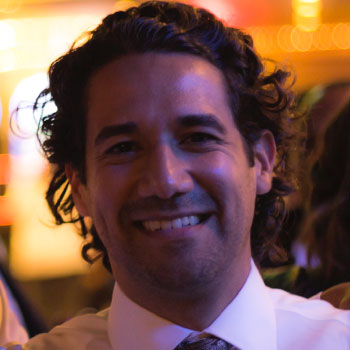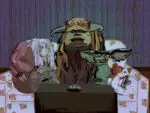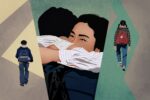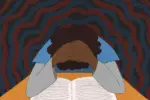Qiana Swan’s award-winning short film “Left in the Dark: Mental Disorders” begins with a provoking question: “What’s the first thing you think of when you hear mental disorder?” The inquiry stokes a range of feelings about the meaning of mental health to students and educators alike. On one side, they are afraid to say the wrong thing, and on the other, they recognize how society as a whole may be failing to address the increasingly relevant issue. The film won a jury award at Campus MovieFest and later was selected for screening at the prestigious Festival de Cannes in France.
Swan is quite familiar with the struggles in which mental disorders can pose for a young person. As a UNC Pembroke psychology student and first-time filmmaker who is still discovering her true calling, Swan is just getting started on her quest to shed light on divisive issues that may be getting overlooked.
Benny Diaz: How did you first develop the idea for “Left in the Dark”?
Qiana Swan: Originally, I was doing a ten-page paper for my English class. For part of the paper I had to have media to present to the class along with the presentation. When I was doing that, I realized I wasn’t going to find any media that has to do specifically with mental disorders, so I decided to just do it myself. Campus MovieFest came on campus and I had never made a movie, so I figured with Campus MovieFest, I needed a movie, so I’ll make one. Boom. Done. It worked.
BD: What kind of obstacles did you face while creating your short film?
QS: The equipment that Campus MovieFest offers is really good equipment, but I didn’t know what any of it did. I never used a MacBook before, I didn’t know how the camera worked, I didn’t even know what ISO meant—it was really difficult. The only software I previously used was Windows Movie Maker from 2007. Progressing from Movie Maker to iMovie was a dramatic step.
I’m now using Adobe, but that’s another ballpark as well. I had to learn how to cut, copy, paste, merge, add music, title screens, introductions and voiceovers—it was a lot. The hardest part, to be completely honest, was that I didn’t know how to scroll on a MacBook. It was so frustrating. I had to go to tech support for help.
BD: As I understand it, you started out interested in acting, but now your focus is on filmmaking. Can you talk about how that changed for you?
QS: I kind of got busy, so I stopped doing acting. Directing you can just do by yourself. You can be in a room with your phone and just film. I feel like you can get your point across if you’re directing better than if you’re acting. If you’re directing, then it’s what you want to say, how you want to say it and when you want to say it. You make it all and then send it out to the world.
BD: Why do you think “Left in the Dark” has ended up gaining so much recognition?
QS: I think it’s mostly because I finished the film and it wasn’t completely terrible, so I wanted to go further. I kind of started doing, I guess, what my dad always taught me. “If I wanted to get this shown,” I asked, “How do I get it shown?” You talk to people. But then I started contacting different newspapers and eventually “The Fayetteville Observer” picked it up, along with our school paper, “The Pine Needle.” And then a whole bunch of other blogs started picking it up and throwing it out there. And then people at school started talking about it. We have a Counseling and Psychological Services on campus, they were very excited about it and they showed it a couple times at school. Just talking and communicating about it was key.
[su_youtube url=”https://www.youtube.com/watch?v=wfdmjy-Dgpw&feature=youtu.be”]
BD: How would you answer the question posed by “Left in the Dark,” if it was presented to you? How have mental disorders affected your life?
QS: I can say that they have negatively and positively affected me. Having them makes things a little difficult. Simple activities are sometimes difficult. At the same time, it’s kind of my inspiration for everything, but I don’t want people to say that I’m trying to market depression or mental disorders. I feel like everyone has something they’re drawn to—their “muse”—so I don’t know.
BD: Mental health is quickly becoming a more central issue in our society. Do you have any opinions to why that is, or what we might be missing?
QS: I know people know about mental disorders, but they don’t really attribute things like depression and anxiety as a mental disorder because they might think it’s a thing that happens with lots of people, so it’s probably not a mental disorder. It’s not an illness, it’s something common. They sort of throw it on the backburner and forget about it.
But then people realize there are all of these medical issues also associated with mental disorders, so it brings it back into the light. There’s a lot. I feel like I can’t even fully begin to explain it all. I don’t feel like there’s a thing on college campuses that explains mental disorders. I guess some schools have a psychological center, we have one, but you have to go in there and get information, but there’s nothing else that’s really out there.
BD: What kind of impact has this whole experience with “Left in the Dark” had on you?
QS: After making a film like this, people are asking what I should do, if I’m going to make a new film, if I’m going to educate people or become a social justice activist, if this is the career I’m going into. People are wondering what I’m going to do next. I’ve become more educated about it because I’m in college and I have to write a lot of essays, so it serves as encouragement for me to do more research.
BD: Your film ends by encouraging viewers to question what they know about mental disorders. Where would you recommend a person start when it comes to learning about mental health?
QS: That’s based on where they are. My college campus offers services for that, you can go in there and get pamphlets, ask them questions. You can also just Google it. I know it sounds weird, but that would get you somewhere. You would have, at least, statistics. You wouldn’t have any personal information but you’d have statistics. And then after you’ve learned a little bit more, maybe you’d start talking to people in your environment. Education through the Internet and then go out to look for help.

















